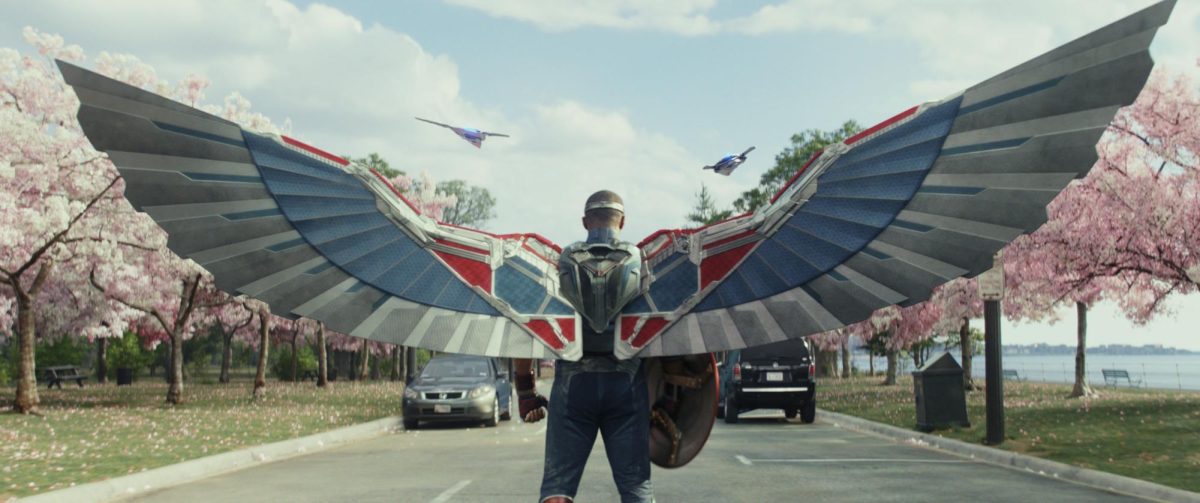Instead of going on a Valentine’s date this past weekend, I chose to watch Marvel Studios “Captain America: Brave New World.” Although the movie is far from romantic, it pleasantly surpassed my expectations through its unforeseen plot twists, real life lessons and special cameos.
“Captain America: Brave New World” has so much exciting material that my Marvel-nerd mind was blown several times throughout the movie. However, to spare the innocent reader from witnessing me going full nerd-mode, I will summarize it to the five main points of interest that stood out to me the most.
Beware, spoilers lurk ahead.
Watch “The Falcon and the Winter Soldier” prior viewing
Marvel films and shows are extremely interconnected, and “Captain America: Brave New World” is no exception. To have the ultimate viewing experience, it would be wise to watch the show “The Falcon and the Winter Soldier” before seeing the film. The average viewer would still be able to enjoy the movie, but I was able to fully understand the film’s complicated storyline because of the background knowledge from the show.
This is mostly due to one of the film’s storylines revolving around Isaiah Bradley played by Carl Lumbly. Bradley is an elderly ex-supersoldier who was wrongfully imprisoned and experimented on by the government for 30 years, which was covered by “The Falcon and the Winter Soldier.”
Nobody knew about his story because the government covered it up. In the film, Bradley is a key character because he was wrongfully accused of an assassination attempt on President Thaddeus Ross, played by Harrison Ford, during a summit meeting with other world leaders.
Streamed on Disney+, “The Falcon and the Winter Soldier” also explains how the film’s protagonist Sam Wilson, played by Anthony Mackie, became the new Captain America.
Political corruption
President Ross is a piece-of-work politician with anger and ego issues. In “Captain America: Civil War,” Ross was one of the main individuals who forced the controversial Sokovia Accords onto the Avengers, a document that would put them under government control. The Sokovia Accords resulted in the polarization of the Avengers, over politics.
In “Captain America: Brave New World,” Ross, the one who played a role in ripping the Avengers apart, tasked Wilson with rebuilding a new team. The hypocrisy was unreal. I could not believe what I was watching.
This plot line reflects real life politics, when politicians will change their tune when times get tough. One scene that stood out is when Ross bargained with Japan’s president. He attempted to use his personal relationship with him and his own cunning to get what he wanted.
Ross is an ambitious and corrupt politician. He is obsessed with his public image and his political agenda, throwing justice away for his own plans. He also used his power to manipulate others, even going as far to expose another character, Samuel Sterns, to 16 years of cruel gamma radiation experimentation.
The return of Bucky Barnes
With the upcoming release of “Thunderbolts*” I was not expecting Bucky Barnes, played by Sebastian Stan, to have a surprise cameo in “Captain America: Brave New World.” He makes a short appearance to give Wilson some encouragement after his sidekick, Torres, was severely injured during a battle.
When I saw Barnes appear on screen, my jaw dropped. I was so excited to see one of my favorite MCU characters. I was so ecstatic it was almost ridiculous.
What shocked me even more about Barnes’ return is that he is now running for Congress. Here was a man, absolutely broken from what HYDRA put him through, suffering from extreme guilt and nightmares. Now, he is making a difference as a politician –- the ultimate comeback story.
A heightened sense of humanity
“Captain America: Brave New World,” had its fair dose of intense fight scenes, but also a sense of humanity that stands out from other Marvel films I have seen. This can be seen in the film’s awkward character dialogue and humor attempts, such as the banter between Wilson and Torres and Barnes’ clumsy attempts to motivate Wilson.
This highlights how the crime fighting, kickass superheroes we have grown to love are also humans with their own quirks and cringey moments. However, I think many can agree that nobody gave better speeches in the MCU than Captain America, Steve Rogers himself.
The film also had more emotional undertones that stand out from other movies that focus more on explosions and punching. One scene that utilized emotional undertones was when Wilson went to visit Isaiah Bradley in prison. The raw emotion Lumbly brought to the scene is a powerful representation of how incarceration can impact an individual.
There were also clear character arcs in the film, especially of the antagonist Ross, who we later discovered was Red Hulk. Ross is an extremely disturbed and messed up character. However, he learns to take responsibility for his actions and is a heartbroken father who wants to connect with his estranged adult daughter.
The final fight
The final showdown between Wilson and Ross in his Red Hulk form was nothing short of intense and brutal. Red Hulk was a formidable opponent against Wilson, able to withstand bullets and leap hundreds of feet into the air.
I was on the edge of my seat as I watched Red Hulk destroy the White House, ram through the wall of the Washington Monument and destroy an entire park of cherry blossom trees. We also finally see the scene that was played over and over again in the film’s trailers since day one –- when Wilson challenges Red Hulk to “come and get me.”
I felt satisfied with the film’s events. However, I know my Marvel movies too well. I knew there would be a post-credits scene so I sat through 10 minutes of credits until the very end. The short clip hinted at future multiversal threats . . . and that Captain America will be back.
Elena Mendonsa can be reached at orionmanagingeditor@gmail.com






